Gazing up at night sky can often take your breath away. But capturing that ethereal view can be difficult. Luckily, there are many talented astroimagers across the globe that use their cameras to turn the heavens into art.
This year, 1,122 entries were submitted to the “Capture the Dark” contest, which was broken into several categories and sponsored by the International Dark-Sky Association and Lowell Observatory. Photographers from 68 different countries scattered across the globe participated in the competition, but only a select few were chosen as winners for each category. Below are the winning and runner-up shots, along with the honorable mentions, from this year’s contest.
For more information about how to enter next year’s "Capture the Dark" contest, visit darksky.org
Connecting to the Dark:
- 1st Place - “In the Search of the Core” by Egon Filter

In their own words: "The night is really a beautiful moment to enjoy all the beauties of the sky. Here the plan was to reflect as many sights as possible in the water and the mirror – with the curious human being searching them in the small square in his hands.
We as humans should learn (relearn, in fact) to admire this scene in order to preserve it. Our challenge is to minimize the impact of light pollution while we grow as a civilization."
Location: Mostardas, State of Rio Grande do Sul, Brazil
- 2nd Place (Tie) - “Magical Night for a Mother and Son” by Likai Lin

In their own words: "In May every year, the Phoenix flowers are in full bloom. In front of an old primary school, a mother and her son are experiencing this magical night: groups of fireflies twinkle under the Phoenix trees, and the stars in the sky revolve around the North Star, which gives us a feeling of time flying and instant solidification."
Location: Jiangmen, Guangdong, China
- 2nd Place (Tie) - “Norrsken over Vintergatan” by Stefano Astorri

In their own words: " The shot was taken in March 2021 in the Swedish Lapland. It was a very cold and windy night. I went to the location hoping to see the northern lights right between two peaks when they all of a sudden started dancing on my left, with the winter Milky Way right behind me. I immediately re-adjusted the composition and the result is a photo that is actually a merge of 12 vertical shots to fully cover the two overlapping arches created by the northern lights and the Milky Way."
Location: Laplan, Sweden
International Dark Sky Place:
- 2nd Place - “Cosmic Connection” by Lindsey Hofstra

In their own words: In 2017 Joshua Tree National Park was designated as an International Dark Sky Park. Because of this designation, Joshua Tree National Park will continue to be a haven for astrophotographers and everyone who wants to see and feel connected to the cosmos around us.
Location: Location: Joshua Tree National Park, California, USA
The Impact of Light Pollution:
- 1st Place - “From Light to Dark” by Noel Benadom

In their own words: "This is a 44-image panorama taken atop the hills outside the city of Pocatello, Idaho. On the left is the light pollution from the city, obscuring the Milky Way. Towards the right, the skies around Caribou National Forest are much darker, and the Milky Way’s core is completely visible."
Location: Pocatello, Idaho, USA
- 2nd Place - “RMNP Light Pollution” by Brandt Ryder

In their own words: "Colorado is fighting to protect its dark skies but as the front range grows the darkness is disappearing. Here light pollution from Denver metro is seen over Longs Peak in Rocky Mountain National Park."
Location: Rocky Mountain National Park, Colorado, USA
- 3rd Place - “The Dreamlike Sky Above the Sea of Clouds” by Likai Lin

In their own words: "The changeable clouds just blocked the light pollution of the city, at the same time, the sea of clouds was illuminated colorful, making the starry sky more dreamy.In the upper right of this picture, we can see the bright and rare Canopus in the Northern Hemisphere."
Location: Guangdong, China
The Bright Side of Lighting:
- 1st Place - “Star Trails Above the Gran Theater” by Likai Lin
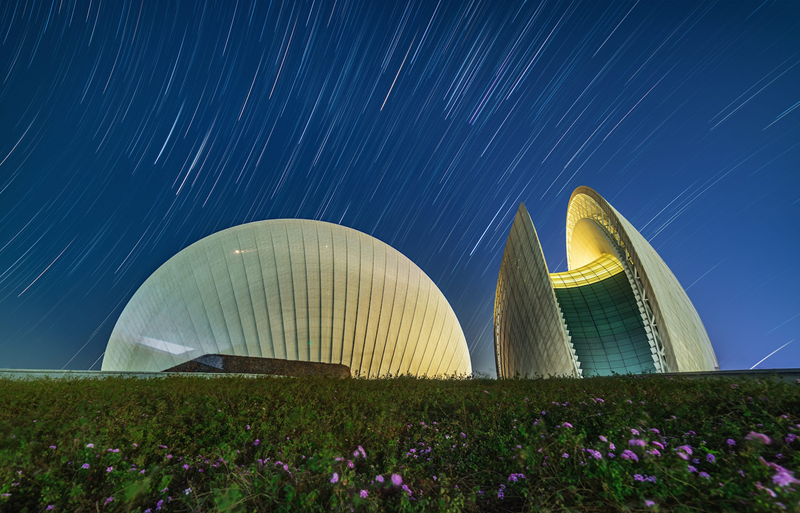
In their own words: "Zhuhai Grand Theater is the first and only opera house at sea in China, which has become the new city landmark of Zhuhai City. This picture is composite stacked by almost 100 photos with the same exposure time of 30 seconds. We can distinguish the trail of Sirius and Orion in the middle of the sky, and the most distinctive one is the Orion Nebula which is purple. Meanwhile, Zhuhai Grand Theater also show its best advantage with stunning yellow light that respects the dark."
Location: Guangdong, China
- 2nd Place - “Marfa Gardens and the Milky Way” by Stephen Hummel
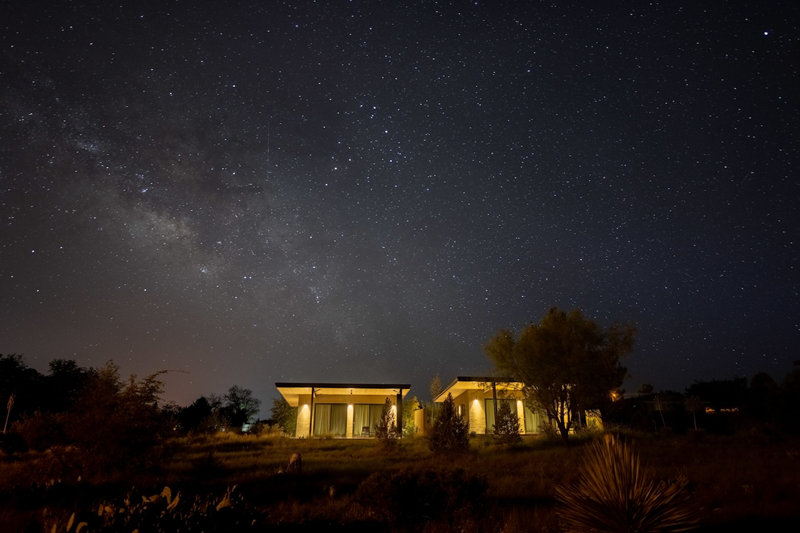
In their own words: "This photo shows a pair of guesthouses illuminated with shielded, dimmable 2700K LED lights. The light fixtures provide enough illumination to see safely, but their proper shielding prevents light from being wasted or producing glare. Even with the lights on, the Milky Way is clearly visible above in this single 30-second exposure."
Location: Marfa, Texas, United States
- 3rd Place -The Bright Side of Lighting: “Nothern Nights” Marybeth Kiczenski

In their own words: "In the far reaches of Michigan’s Upper Peninsula, you’ll find a place where the only lights are those that are needed – such as lighthouses. As such, nature’s light show – the Aurora – takes center stage!"
Location: Eagle Harbor, Michigan, USA
Creatures of the Night:
- 1st Place - “Nesting Under the Milky Way” by Mihail Minkov

In their own words: "This is a shot I took last year over July. There was a stork nest, near my village house close to a road with intensive traffic. During the day I was thinking that would be great to manage to capture the storks with the Milky Way core behind them. The same night, the weather was perfect and I was on the location. I made a few test shots. This one is 13″ single shot, and before some of you start arguing that this is impossible, the stork stay in that position for about a minute before made any move. I took about 15 single exposures before I decide to go back home. The light that lighted the nest is from a car coming from the distance."
Location: Detelina Village, near the city of Varna, Bulgaria
- 2nd Place - "Qualcosa brilla lassù e qualcosa quaggiù (Something shines up there and something down here)" by Elena Paschetto

In their own words: "Once upon a time, to enjoy such a spectacle, it was enough to go to a wood. Now with light pollution, fireflies find it increasingly difficult to find a partner and reproduce, due to the excessive brightness of the environment at night and their number has drastically dropped. Only in photography can we enjoy this spectacle that light pollution has stolen from us."
Location: Giardino di casa Sanfront Cuneo Italia
- 3rd Place -Creatures of the Night: “Moonset Fireflies” by Bill Longo

In their own words: Without darkness, fireflies would not have the ability to find each other, and there would be no fireflies.
Location: Kirkfield, Ontario, Canada
Deep Sky:
- 1st Place - “Cold Orion Region with a Warm Heart” by Antoine & Dalia Grelin
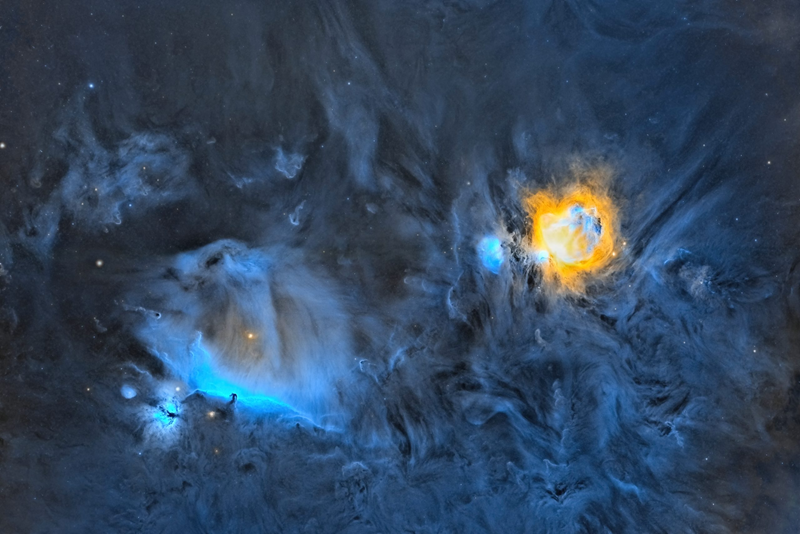
In their own words: This image shows the Orion Nebula, De Mairan’s Nebula, the Horsehead Nebula, and the Flame Nebula. It was taken with a small refractor telescope from the city. For this, narrowband filters were used and long exposure times helped reveal a lot of gas and dust all around the nebulae. The color was achieved by combining the narrowband channels into an “OHS” combination. This is rarely done and gives this part of the sky a unique look.
Location: Las Vegas, NV, USA
- 2nd Place - “Orion” by Matt Dieterich
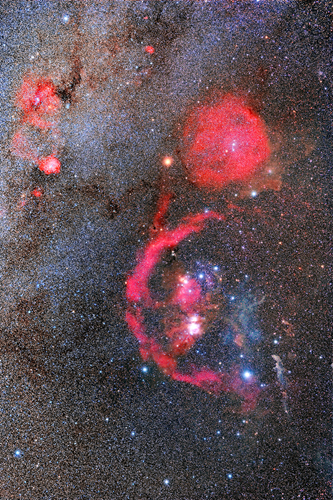
In their own words: I have wanted to capture a long exposure of the constellation Orion to reveal many of the beautiful deep sky objects for quite a few years. The red emission nebulae surrounding Orion, such as Barnard’s Loop, require dark night skies to be fully revealed. I hope this inspires you to attempt your own images of this stunning area!
Location: Fort Davis, Texas in the USA
- 3rd Place - “Cygnus Mosaic in Hubble Palette” by Ciaran O’Donnell
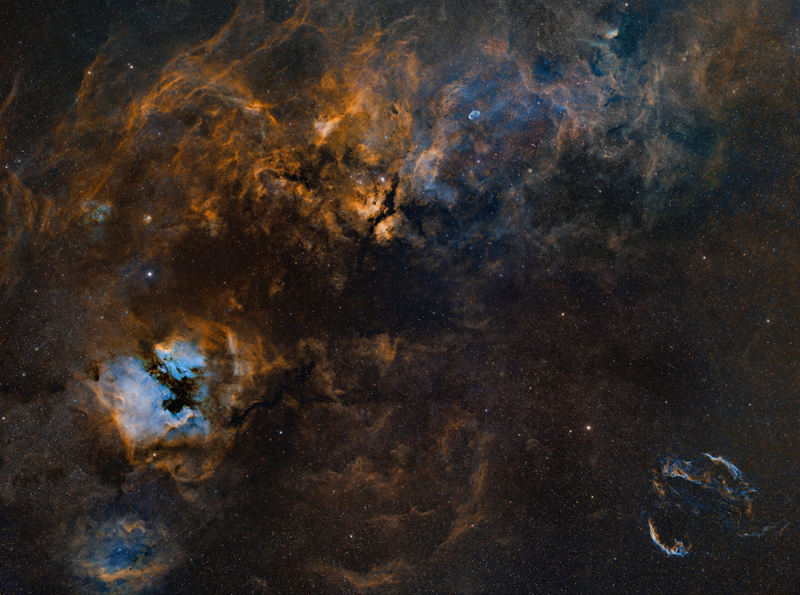
In their own words: "Mosaic of the Cygnus area in SHO with an Atik383l+."
Location: Jordanstown, Northern Ireland
The Mobile Photo:
- 1st Place - “Seaside” by Ziyi Ye

In their own words: "I climbed to the high rock of the sea and face the Milky Way, everything around me is dark and unknown, I can hear the sea wave beating and my heartbeat clearly."
Location: Hainan, China
- 2nd Place - “The Center of Milky Way” by Chin Wei-Loon

In their own words: "The mobile phone has f/1.8 lens and Pro-mode for adjusting shutter speed & ISO value manually. Furthermore, it provides RAW image files! This sounds good for astrophotography. This photo is among the very first few images taken using a mobile phone. With stacking technique could further reduce the noise in the photo."
Location: Pekan Nabalu, Sabah, Malaysia
- 3rd Place - “Venus & Moon with a Cheap Mobile Phone” by Pavel Vorobiev

In their own words: "Modern mobile phones, even the cheapest ones like this, surprise us with very capable cameras, offering great resolution, sensitivity, and dynamic range. This conjunction of Venus and Moon was shot with a simple tripod adapter. Mobile starscape/astrophotography could be the first door to this magnificent hobby or even a serious backup instrument for experienced astrophotographers."
Location: Playa del Carmen, Quintana Roo, Mexico
Youth:
- 1st Place - “Stairs to the Heavens” by Jai Shet

In their own words: In April 2021, I camped with my family in Big Bend National Park in Texas. I woke up at 2:00 a.m. with my younger brother and hiked up a 1-mile mountain trail. On the way up, a flight of stairs seemed to ascend to the galaxy core. I stood at the very top and took a ‘selfie’ with my wireless camera remote. After a whole year of staying at home due to Covid-19, I was overjoyed to capture the milky way after such a long time.
Location: Big Bend National Park, Texas, USA
- 2nd Place - “The Night Sky Party” by Neil Shet

In their own words: This 360-degree panorama contains a lot of the wonders of the night sky. Starting from the left of the image, bright zodiacal light beams out from the horizon with Jupiter and Saturn smothered by it. Starlink satellites trail perfectly over one of the Toadstool Hoodoos. The Milky Way arches over the biggest hoodoo while the Andromeda Galaxy near the upper-right claims the best seat in town. Coincidently, the Pleiades star cluster, Andromeda, and Mars form a triangle. A total of 50 images were combined to make this mosaic, not to mention the freezing cold weather.
Location: Kanab, Utah, USA
- 3rd Place - “The Veil Nebulas of Cygnus” by Carl Crum

In their own words: "When starting out in astrophotography, imagers often shoot well-known objects. As a 15-year-old with only a couple of months’ experience, I was mesmerized by the Veil Nebulas: the remnants of a star that had blown itself to ribbons! This was one of my first attempts at narrowband-imaging with a one-shot color camera, which not only challenged my patience in the field but also my image-processing abilities."
Location: Angwin, California, USA
Source: Astronomy Magazine